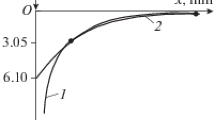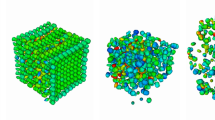Abstract
The problem of contact between two elastic bodies is addressed computationally using the virtual element method (VEM). The use of the VEM allows the use of non-matching meshes for the two bodies, and hence obviates the need for node-to-node contact on the candidate contact interfaces. The contact constraint is imposed using either a Lagrange multiplier or penalty formulation. A number of numerical examples illustrate the robustness and accuracy of the algorithm.















Similar content being viewed by others
References
Wriggers P (2006) Computational contact mechanics, 2nd edn. Springer, Berlin
Laursen TA (2002) Computational contact and impact mechanics. Springer, Berlin
Hallquist JO (1979) NIKE2d: an implicit, finite-deformation, finite element code for analysing the static and dynamic response of two-dimensional solids. Technical Report UCRL–52678, Lawrence Livermore National Laboratory, University of California
Wriggers P, Simo J (1985) A note on tangent stiffnesses for fully nonlinear contact problems. Commun Appl Numer Methods 1:199–203
Hallquist JO, Goudreau GL, Benson DJ (1985) Sliding interfaces with contact-impact in large-scale Lagrange computations. Comput Methods Appl Mech Eng 51:107–137
Pietrzak G, Curnier A (1997) Continuum mechanics modeling and augmented Lagrange formulation of multibody, Large deformation frictional contact problems. In: Owen DR, Hinton E, Onate E (eds) Proceedings of COMPLAS 5. CIMNE, Barcelona, pp 878–883
Padmanabhan V, Laursen T (2001) A framework for development of surface smoothing procedures in large deformation frictional contact analysis. Finite Elem Anal Des 37:173–198
Wriggers P, Krstulovic-Opara L, Korelc J (2001) Smooth \({C}^1\)- interpolations for two-dimensional frictional contact problems. Int J Numer Methods Eng 51:1469–1495
Krstulovic-Opara L, Wriggers P, Korelc J (2002) A \({C}^1\)-continuous formulation for 3D finite deformation frictional contact. Comput Mech 29:27–42
Wohlmuth BI (2000) A mortar finite element method using dual spaces for the Lagrange multiplier. SIAM J Numer Anal 38:989–1012
Wohlmuth B, Krause R (2004) Monotone methods on non-matching grids for non linear contact problems. SISC 25:324–347
Puso MA (2004) A 3D mortar method for solid mechanics. Int J Numer Methods Eng 59(3):315–336
Puso MA, Laursen TA (2004) A mortar segment-to-segment contact method for large deformation solid mechanics. Comput Methods Appl Mech Eng 193:601–629
Flemisch B, Puso MA, Wohlmuth B (2005) A new dual mortar method for curved interfaces: 2D elasticity. Int J Numer Methods Eng 63:813–832
Fischer KA, Wriggers P (2005) Frictionless 2D contact formulations for finite deformations based on the mortar method. Comput Mech 36:226–244
Fischer KA, Wriggers P (2006) Mortar based frictional contact formulation for higher order interpolations using the moving friction cone. Comput Methods Appl Mech Eng 195:5020–5036
Tur M, Fuenmayor F, Wriggers P (2009) A mortar-based frictional contact formulation for large deformations using Lagrange multipliers. Comput Methods Appl Mech Eng 198:2860–2873
Popp A, Gitterle M, Gee M, Wall WA (2010) A dual mortar approach for 3D finite deformation contact with consistent linearization. Int J Numer Methods Eng 83(11):1428–1465
Temizer I, Wriggers P, Hughes TJR (2011) Contact treatment in isogeometric analysis with NURBS. Comput Methods Appl Mech Eng 200:1100–1112
de Lorenzis L, Temizer I, Wriggers P, Zavarise G (2011) A large deformation frictional contact formulation using NURBS-based isogeometric analysis. Int J Numer Methods Eng 87:1278–1300
Temizer I, Wriggers P, Hughes TJR (2012) Three-dimensional mortar-based frictional contact treatment in isogeometric analysis with NURBS. Comput Methods Appl Mech Eng 209–211(2012):115–128
de Lorenzis L, Wriggers P, Zavarise G (2012) Isogeometric analysis of 3D large deformation contact problems with the augmented Lagrangian formulation. Comput Mech 49:1–20
Sukumar N (2004) Construction of polygonal interpolants: a maximum entropy approach. Int J Numer Methods Eng 61:21592181
Sukumar N, Malsch EA (2006) Recent advances in the construction of polygonal finite element interpolants. Arch Comput Methods Eng 13:129163
Biabanaki S, Khoei A (2012) A polygonal finite element method for modeling arbitrary interfaces in large deformation problems. Comput Mech 50:1933
Biabanaki S, Khoei A, Wriggers P (2014) Polygonal finite element methods for contact-impact problems on non-conformal meshes. Comput Methods Appl Mech Eng 269:198221
Chi H, Talischi C, Lopez-Pamies O, Paulino GH (2015) Polygonal finite elements for finite elasticity. Int J Numer Methods Eng 101(4):305–328
Beirão da Veiga L, Brezzi F, Cangiani A, Manzini G, Marini L, Russo A (2013) Basic principles of virtual element methods. Math Models Methods Appl Sci 23(01):199–214
Beirão da Veiga L, Brezzi F, Marini LD, Russo A (2014) The Hitchhiker’s guide to the virtual element method. Math Models Methods Appl Sci 24(08):1541–1573
Beirão Da Veiga L, Brezzi F, Marini L (2013) Virtual elements for linear elasticity problems. SIAM J Numer Anal 51(2):794–812
Gain AL, Talischi C, Paulino GH (2014) On the virtual element method for three-dimensional linear elasticity problems on arbitrary polyhedral meshes. Comput Methods Appl Mech Eng 282:132–160
Bathe K-J, El-Abbasi N (2001) Stability and patch test performance of contact discretizations and a new solution algorithm. Comput Struct 79(16):1473–1486
Johnson K L (1985) Contact mechanics. Cambridge University Press, Cambridge
Acknowledgments
Special care had to be taken to obtain the smootheness of the displacement and contact tractions at the contact interface. In this context the authors would like to thank Prof. Franco Brezzi for pointing out a method for a special stabilization that enhanced the results considerably, see Sect. 3.2. The third author acknowledges the generous support of the Alexander von Humboldt Foundation, through a Georg Forster Research Award.
Author information
Authors and Affiliations
Corresponding author
Rights and permissions
About this article
Cite this article
Wriggers, P., Rust, W.T. & Reddy, B.D. A virtual element method for contact. Comput Mech 58, 1039–1050 (2016). https://doi.org/10.1007/s00466-016-1331-x
Received:
Accepted:
Published:
Issue Date:
DOI: https://doi.org/10.1007/s00466-016-1331-x




